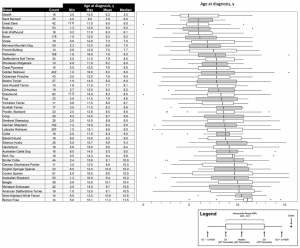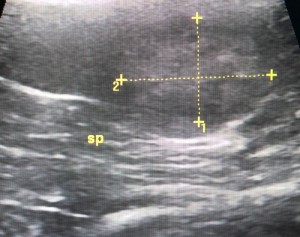When Should Cancer Screening Start? New study shows it depends on breed and weight.
Cancer is the leading cause of death in dogs. It affects some breeds, and some size dogs, more than others. For example, more than 50% of Flat-Coated Retrievers and Irish Water Spaniels die of cancer, while the rate is much lower in other breeds, especially small breeds such as Dachshunds and Shih Tzus. But even 15 to 20% of dogs in these breeds die of cancer. In humans, cancer-screening is considered an essential part of health care, as early detection can sometimes prevent or delay death from cancer.
In recent years blood-based cancer-screening tests have made cancer-screening for dogs more available. But when should they be used? They need to be used early enough so that effective steps can be taken to treat the cancer, but not so early that owners spend funds unnecessarily. This best age to start screening may depend on breed, weight and other factors.
To answer this question, researchers analyzed data from almost 3500 cancer-diagnosed dogs to determine factors associated with age at diagnosis. Overall, the median age of diagnosis was 8.5 years.
- Castrated males were diagnosed at younger ages than spayed females. (8.5 yrs vs 8.9)
- There was no difference between intact males and females. (7.6 yrs vs 7.3)
- Intact males were diagnosed at younger ages than castrated males. (7.6 yrs vs 8.5)
- Intact females were diagnosed at younger ages than spayed females. (7.3 yrs vs 8.9)
- Purebreds were diagnosed at younger ages than mixed breeds.
- Heavier dogs were diagnosed at younger ages than lighter weight dogs.
 The most commonly diagnosed cancers were lymphoma, osteosarcoma, mast cell tumor, hemangiosarcoma, and soft tissue sarcoma, but these rates could be influenced by the breed and size of dogs in the study. Median age at diagnosis for mast cell tumors and blood-related cancers such as lymphoma, and hemangiosarcoma were significantly younger than malignant melanoma or lung cancer.
The most commonly diagnosed cancers were lymphoma, osteosarcoma, mast cell tumor, hemangiosarcoma, and soft tissue sarcoma, but these rates could be influenced by the breed and size of dogs in the study. Median age at diagnosis for mast cell tumors and blood-related cancers such as lymphoma, and hemangiosarcoma were significantly younger than malignant melanoma or lung cancer.
Breeds in which the data set included 10 or more individuals were compared for age at diagnosis. Mastiffs had the youngest age, followed by Saint Bernards, Great Danes, Bulldogs and Boxers. Bichon Frises had the oldest age, followed by West Highland Whites, American Staffordshire Terriers, Miniature Schnauzers and Beagles.
Although in general heavier dogs were diagnosed at younger ages, certain breeds (in particular, Bulldogs, Boxers, Vizslas, French Bulldogs, and Boston Terriers) had median ages at diagnosis two or more years younger than their weight predicted.
In line with human cancer screening, canine cancer screening should start before the median age of diagnosis. These estimates enable a veterinarian or dog owner to arrange screening at variable ages depending on their dog’s breed and weight. The authors suggest screening by liquid biopsy (blood sample) should be initiated starting two years before the median age of diagnosis for a particular weight or breed. Those estimates are listed in the paper.
Short URL: http://caninechronicle.com/?p=260246
Comments are closed













